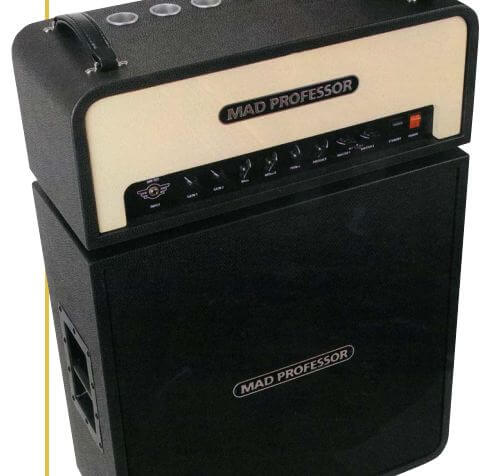
MAD PROFESSOR AMPLIfication founder Harri Koski built his reputation first by distributing high-quality effects pedals hand-made in Sweden by amp and pedal designer Bjorn Juhl, and later by building an amplifier and pedal company around Juhl’s design work. A couple years ago he decided to build a new guitar amplifier that would complement his pedals, so he teamed up again with Juhl. The culmination of their work is the MP101. A 100-watt channel-switching head, the MP101 is hand-made by Koski’s company in Finland. Dressed in black-and-tan Tolex on a Baltic birch cab, its front panel has controls for Volume for each channel, as well as Treble, Middle, Bass, Presence, Master 1, and Master 2, and a channel switch for use when the foot switch is not connected. Removing the back panel reveals a preamp section consisting of five 12AX7s, and a power section of four TADEL34Bs and two oversized Mercury Magnetics transformers that help the amp handle transients and give it tight bass response. Inside, one can see Koski and Juhl have eyes for detail, given (among other things) the MP101’s perfectly curved Baltic birch cab.
On the back panel, the MP101 has five speaker outputs, two 4-ohm, two 8-ohm, and one 16-ohm. There’s also an effects loop and a foot switch jack for channel switching. Classy-looking air vents lend an aesthetic highlight to the top and back of the cab. We plugged the MP101into a Celestion-loaded 4×12 and opted for three guitars to test the MP; a Gibson Les Paul ’59 Reissue, a PRS Swamp Ash Special, and an ’87Fender Strat. Plugging in, one is met with a number of revelations. First is how the MP101 has a tone of volume on tap, yet it’s amazingly responsive, regardless of where you set the master Volume. Plugging into Channel 1 with the PRS at a very low volume setting, the amp easily fills a room, and surprisingly, can be made to overdrive via simple pick attack. The channel is never perfectly clean with humbuckers or healthy volume-knob roll-off. Second, the amp has a very wide frequency range; this is due in part to circuit design and the oversized output tranny (SRV put a larger Bassman tranny in his Super Reverb to get clear low end). Even with the Strat, the Mad Professor produced thick lows and smooth highs.
A third revelation; with its tight power section, Channel 1 is very reminiscent of a Marshall Majoror Hi-Watt, but again, with a respon-sive preamp.
Switching to Channel 2, the dirt level rises dramatically. Even with Volume 2 on a very low setting, the amp has more than a tow-sack full of grind on-hand. This channel is a rock beast regardless of guitar or pickups! Like any amp with two channels that share an EQ section, a dedicated Middle control here would be nice. Rolling up the Master control, the amp gets louder and louder until you essentially cannot stand in the room with it! We were left scratching our heads at the 100-watt rating.
After putting the amp through its paces dry, we setup a bevy of stomp-boxes in front of it. Since the MP was designed to be pedal-friendly, it was no surprise it handled all things stomp-box. With everything from fuzz to chorus to extreme boost, the Professor was more than amicable. Echo effects through Channel 2 sounded notably better run through the effects loop.
The MP101 is a robust rock workhorse with a very high level of build quality and attention to detail.
Again, this amp has a ton of volume on tap, so it isn’t for the bed-room player or coffeehouse plunk-er. No, sir. This one is for larger venues, where it can express itself via its thunderous volume, responsive preamp, and wide frequency range. An overbuilt 100-watt head that traces its roots to high-powered British amps, the MP101 has power to pummel the average play-er and his 4×12 into complete submission!—Zac Childs